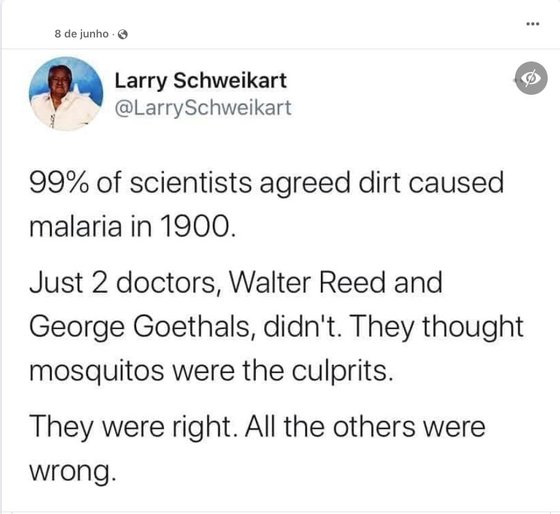Malaria is a disease caused by the parasite plasmonium, transmitted to humans through the bite of an infected mosquito of the Anopheles genus, explains the World Health Organization. Although the disease has existed for thousands of years, research since the end of the 19th century was essential to determine its origin and form of transmission.
But according to one mail of Facebook, which generated more than 1,500 shares, just over a century ago (in 1900), only two doctors (Walter Reed and George Goethals) believed that the disease was caused by a parasite transmitted to humans by mosquitoes, on the contrary than the rest of the scientific community who at the time supposedly considered dirt to be the main cause of disease.
The history of malaria and scientific research indicate otherwise. There are several documents that show that experts not only discovered that malaria was caused by a parasite, but were able to link the transmission of the disease to mosquito bites before the 20th century. The same documents show that in 1900 there was already a consensus on the matter.
Furthermore, Walter Reed and George Goethals were never involved in the study of malaria, the Britannica website shows. According to the English encyclopedia, Reed was a US Army pathologist and bacteriologist who showed that yellow fever was transmitted by mosquitoes, after the thesis on the transmission of malaria was already closed. Goethals was a US Army officer who helped build the Panama Canal.
The discovery of the parasite and the relationship with mosquitoes
In 1880, Charles Louis Alphonse Laveran, a French army doctor, a key figure in the study of malaria, suspected that the disease was caused by a parasite and not miasma (decaying organic waste, previously thought to cause malaria). the illness). “Laveran knew, from contemporary scientific articles, that many diseases previously attributed to miasms, or malignant vapors, were actually caused by microbes”, can be read in the book “Saving Lives, Buying Time: Economics of Malaria Drugs in Age of Resistance In October of that year, he proved his theory: he discovered the malaria parasite while studying blood samples from patients.
“His first claims about malaria parasites were met with a lot of skepticism, but scientists in all countries gradually published research that confirmed it.” In 1889, the Academy of Sciences distinguished him for his discovery, which since then “has been undisputed, of malaria parasites”, can be read on the website of the Nobel Prize, which awarded him the award in 1907.
Although he suspected it, he never managed to establish a link between the disease and mosquitoes. It was Ronald Ross, the English doctor who, in 1894, began to collect evidence on the life cycle of malaria in these animals, having received the Nobel Prize for Medicine in 1902.
“In 1894 he decided to carry out experimental research in India on Laveran and Manson’s hypothesis that mosquitoes are related to the spread of disease,” reads his biography. The discovery came two and a half years after he began the research: “Ross was able to demonstrate the life cycle of malaria parasites in mosquitoes, thus establishing the hypothesis of [Charles] laveran and [Patrick] Manson.”
It is a group of Italian researchers (among which are Amico Bignami, Giovanni Battista Grassi or Giuseppe Bastianelli) who, in 1898, made the definitive discovery, managing to demonstrate that the parasite was transmitted to humans through this insect, he points out the scientific journal Parasites & Vectors.
In 1900, Patrick Manson, a Scottish physician who was instrumental in the study of parasites and founder of Tropical Medicine, published the scientific article “Experimental Evidence on the Mosquito-Malaria Theory”, demonstrating that at that time the discoveries about malaria were already widespread and accepted among the scientific community: “The theory that the malaria parasite is transmitted from man to man by a particular species of mosquito is now accepted by all biologists and physicians who have given due attention to the matter.”, can be read.
conclusion
It is false to say that in 1900 only two experts believed that malaria was a parasite transmitted by mosquitoes and that 99% of the scientific community attributed the disease to dirt. In addition to the fact that Walter Reed and George Goethals were not linked to malaria research, scientific research shows that the main discoveries about this pathology occurred at the end of the 19th century. In 1880 malaria was discovered to be a parasite, in 1897 a link between the disease and mosquitoes was established and in 1989 a group of Italian researchers definitively demonstrated that malaria was transmitted to humans through the bite of these infected insects. for the disease.
Thus, according to the Observer classification, this content is:
WRONG
In the Facebook classification system this content is:
FAKE: The main content claims are factually inaccurate. This option typically matches “false” or “mostly false” ratings on fact-checking websites.
NOTE: This content was curated by The Observer as part of a fact-checking partnership with Facebook.

Source: Observadora
